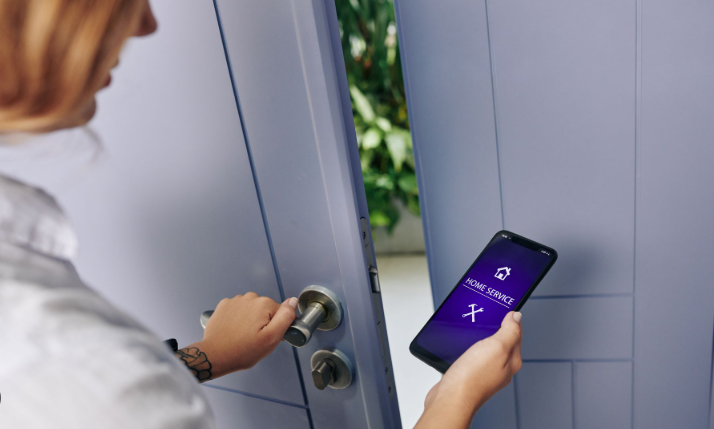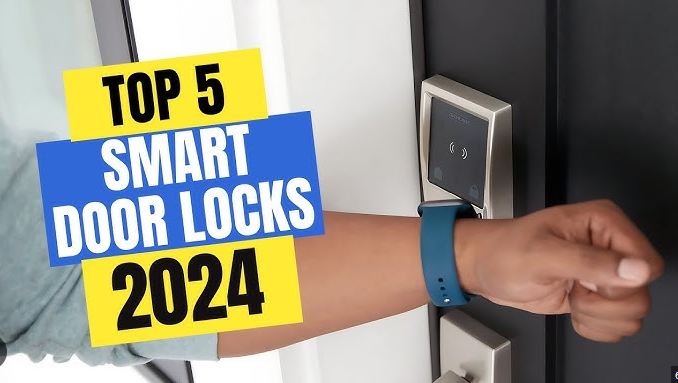As smart home technology continues to evolve, many homeowners are asking, “Are smart locks safe?” With the rise in popularity of smart locks, it’s natural to question whether these high-tech devices can provide the same level of security as traditional locks—or even surpass them. Smart locks offer convenience, remote access, and integration with smart home systems, but their reliance on technology raises concerns about potential vulnerabilities like hacking. In this detailed guide, we’ll explore the safety of smart locks, covering their security features, potential risks, and best practices for smart lock installation, maintenance, and troubleshooting. By the end, you’ll have a clear understanding of whether a smart lock is a safe and reliable choice for your home.
What Are Smart Locks and How Do They Work?
Before diving into the question “Are smart locks safe?”, let’s first understand what smart locks are. Unlike traditional deadbolts that require a physical key, smart locks use advanced technologies like Wi-Fi, Bluetooth, or Z-Wave to enable keyless entry. You can unlock your door using a smartphone app, a PIN code, voice commands through a smart assistant, or even biometric features like fingerprint scanning. Some models also allow remote access, letting you control your lock from anywhere with an internet connection.
These features make smart locks incredibly convenient, but they also introduce unique security considerations. While traditional locks are susceptible to physical attacks like lock-picking or key duplication, smart locks face digital threats such as hacking or software glitches. To determine if smart locks are safe, we need to evaluate their security features, potential vulnerabilities, and how to mitigate risks through proper smart lock setup and maintenance.

Key Security Features That Make Smart Locks Safe
When considering whether smart locks are safe, it’s essential to look at the security features offered by high-quality models. A reliable smart lock guide can help you choose a lock with robust safety measures. Here are some of the key features that contribute to smart lock safety:
- Advanced Encryption: Top-tier smart locks use military-grade encryption protocols, such as AES-128 or AES-256, to secure communication between the lock and your smartphone or smart home hub. This ensures that data transmitted during remote access or when you connect a smart lock to your network is protected from interception.
- Two-Factor Authentication (2FA): Many smart locks offer 2FA, requiring a second form of verification (like a PIN or biometric scan) in addition to your smartphone app, adding an extra layer of security.
- Physical Durability: The best smart locks are built with tamper-resistant materials and designs, making them as difficult to break as high-quality traditional locks.
- Activity Logs: Smart locks often provide real-time activity logs, allowing you to monitor who enters and exits your home and when, which enhances security oversight.
- Auto-Lock Features: Many models include auto-lock functionality, ensuring your door locks automatically after a set period, reducing the risk of leaving it unlocked.
- Geofencing: Some smart locks use geofencing to automatically lock or unlock based on your smartphone’s location, minimizing unauthorized access.
These features demonstrate that smart locks can be highly secure when designed with safety in mind. However, their effectiveness depends on choosing a reputable model and following proper smart lock installation and setup practices.
Potential Risks and Vulnerabilities of Smart Locks
While smart locks offer advanced security features, no device is entirely immune to risks. To answer “Are smart locks safe?”, we must also consider potential vulnerabilities and how to address them. Here are some common concerns and how they can be mitigated:
- Hacking Risks: Since smart locks rely on digital connectivity, they can be vulnerable to hacking if not properly secured. However, using strong, unique passwords, enabling 2FA, and keeping your lock’s firmware updated significantly reduces this risk.
- Power Dependency: Smart locks rely on batteries, and a dead battery could potentially lock you out. Fortunately, most models have excellent smart lock battery life (often lasting 6–12 months) and provide low-battery alerts well in advance.
- Software Glitches: Like any smart device, software bugs can occasionally cause issues. Regular firmware updates and smart lock troubleshooting can help maintain smooth operation.
- Physical Tampering: While rare, physical attacks on smart locks are possible. Choosing a lock with a high ANSI/BHMA rating ensures it can withstand physical force.
By understanding these risks and taking proactive steps—like choosing a secure model and following smart lock tips for setup and maintenance—you can significantly enhance the safety of your smart lock.
How to Ensure Smart Lock Safety: Best Practices
To maximize the safety of your smart lock, proper installation, setup, and maintenance are crucial. Here are some practical smart lock tips to ensure your lock remains secure:
1. Choose a Reputable Smart Lock
Not all smart locks are created equal. Research and select a model from a trusted brand with strong encryption, regular firmware updates, and positive user reviews. A comprehensive best smart lock guide can help you compare features and choose a lock that meets your security needs.
2. Follow Proper Smart Lock Installation
Correct smart lock installation is critical for both security and functionality. Most smart locks are designed for easy DIY installation, but you must follow the manufacturer’s instructions carefully. Ensure the lock is properly aligned with your door’s strike plate and test it thoroughly after installation. If you’re unsure, consider hiring a professional to avoid installation errors that could compromise security.
3. Secure Your Smart Lock Setup
When setting up your smart lock, take these steps to enhance security:
- Use a strong, unique password for your lock’s app and any associated smart home accounts.
- Enable 2FA if available to add an extra layer of protection.
- Connect your smart lock to a secure Wi-Fi network with WPA3 encryption.
- Avoid using public Wi-Fi networks when accessing your lock remotely.
Proper smart lock setup ensures that your lock communicates securely with your devices and minimizes the risk of unauthorized access.
4. Maintain Your Smart Lock
Regular smart lock maintenance is essential to keep your lock functioning reliably. Check the battery level every few months and replace batteries promptly when low. Most smart locks provide notifications via their app to alert you of low smart lock battery life. Additionally, keep the lock’s firmware updated to patch any security vulnerabilities and ensure optimal performance.
5. Troubleshoot Issues Promptly
If you encounter issues like connectivity problems or unresponsive controls, refer to the manufacturer’s smart lock troubleshooting guide. Common fixes include resetting the lock, re-pairing it with your smartphone, or checking your Wi-Fi connection. Addressing issues quickly prevents potential security gaps.
6. Use a Portable Smart Lock for Temporary Needs
For renters or those who frequently travel, a portable smart lock can be a great option. These locks are easy to install and remove without altering the door, making them ideal for temporary setups. Ensure the portable lock you choose has strong encryption and reliable battery life to maintain security.

Are Smart Locks Safer Than Traditional Locks?
So, are smart locks safe compared to traditional locks? The answer depends on the specific model and how it’s used. High-quality smart locks with advanced encryption, tamper-resistant designs, and regular updates can be just as safe—if not safer—than traditional deadbolts. They offer additional benefits like activity logs, remote control, and integration with smart home systems, which traditional locks lack.
However, smart locks require more proactive maintenance, such as monitoring smart lock battery life and keeping firmware updated. Traditional locks, while simpler, are vulnerable to physical attacks like lock-picking, which skilled intruders can exploit. By choosing a high-quality smart lock and following best practices for smart lock installation and maintenance, you can achieve a level of security that rivals or exceeds that of traditional locks.
Smart Lock Safety for Different Use Cases
Smart locks are versatile and can be used in various scenarios, each with its own safety considerations:
- Homeowners: For permanent installations, choose a smart lock with robust security features and integrate it with a smart home system for enhanced control.
- Renters: A portable smart lock is ideal for renters who need a secure, non-invasive solution that can be easily removed.
- Vacation Rentals: Smart locks are perfect for short-term rentals, allowing hosts to grant temporary access codes to guests and monitor activity remotely.
- Businesses: Commercial-grade smart locks can provide secure access control for offices or small businesses, with features like user management and audit trails.
Regardless of the use case, following smart lock tips like securing your Wi-Fi network and enabling 2FA ensures maximum safety.
Common Myths About Smart Lock Safety
Despite their growing popularity, several myths about smart lock safety persist. Let’s debunk a few:
- Myth: Smart locks are easily hacked. While no device is 100% hack-proof, high-quality smart locks with strong encryption and 2FA are extremely difficult to compromise.
- Myth: Smart locks fail when the power goes out. Most smart locks run on batteries and include a physical key as a backup, ensuring access even during power outages.
- Myth: Smart locks are too complicated to use. Modern smart locks are designed for user-friendliness, with intuitive apps and straightforward instructions for how to pair a smart lock.
By choosing a reliable model and following proper setup procedures, you can dispel these myths and enjoy the benefits of a secure smart lock.
Conclusion: Are Smart Locks Safe?
So, are smart locks safe? The answer is a resounding yes—when chosen wisely and used correctly. High-quality smart locks with advanced encryption, durable designs, and regular updates offer robust security that can rival or surpass traditional locks. By following best practices for smart lock installation, smart lock setup, and smart lock maintenance, you can minimize risks and enjoy the convenience and peace of mind that smart locks provide.
Whether you’re a homeowner, renter, or business owner, a smart lock can enhance your security and simplify your life. For more information on choosing the right model, check out this comprehensive home security tips guide to find the best smart lock for your needs. With the right precautions, a smart lock can be a safe, reliable, and modern solution for protecting your home.